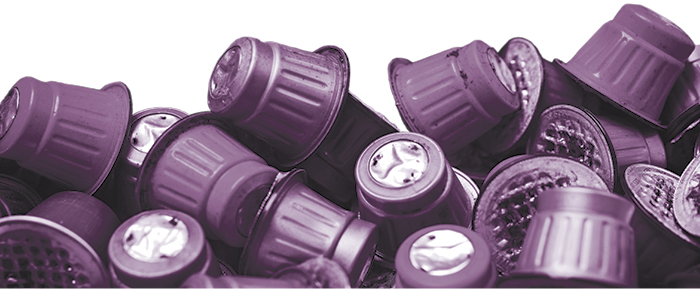1. Make ‘Plastic’ from Food Waste

What if there were a plastic that could actually improve the environment?
Researchers are exploring ways to make the material a little more bio friendly in Drexel’s Natural Materials and Polymer Processing Lab, led by Caroline Schauer, associate dean for research and faculty affairs at the College of Engineering and a professor in the Department of Materials Science.
“By 2050, there will be more plastic in the ocean than fish,” Schauer says. “That’s not that far off.”
Some of Schauer’s protégés are developing polymer composites made with coffee grounds, spent grains from breweries and distilleries, and cranberry and apple pomace left over from juice-making.
Doctoral student Emma Snelling is focusing on the use of cranberry pomace and spent grains as filler material in polymers made from polylactic acid (PLA), which is synthesized from renewable sources such as corn.
The pomace and spent grain may have the potential to strengthen or otherwise enhance PLA’s mechanical properties. This is important, Snelling notes, since recycling plastic diminishes its strength.
Should cranberry pomace prove to be an effective filler for biopolymers like PLA, it could create a durable material that could be repurposed repeatedly.
It would also solve the dilemma of how to dispose of cranberry pomace, which is a problem unique to the United States, Schauer says, because Americans alone have a taste for the sour fruit. Because cranberry growers have, in the past, discarded about one fourth of their annual harvest to sustain market prices, she adds, “we have all of this waste that really doesn’t have a good home.”
Meanwhile another doctoral student, Emily Herbert, is studying how bacteria can reduce the novel polymers into, hopefully, Earth-friendly components. Ideally, Herbert says, “you could throw this thing into the garden or the ocean.”
Because bacteria have demonstrated a keen appetite for spent grain, composites that contain it would degrade quickly, Schauer says.
“That could be good, if it’s a food liner that you use once and then throw away,” she says.
From there, Schauer’s lab has the capacity to transform their new polymers into consumer good prototypes: “A big focus is on how to produce these things; that’s the next step,” she says. “Great, you can make a polymer, but how does it become a computer or a cup? That’s where we come in.”
In three years’ time, Schauer estimates, composites being tested and produced in her lab could be ready to attract the interest of commercial producers. From there, such items might just be a year or two from showing up on store shelves.
— Sarah Greenblatt
_______
2. Find Good (Re)Uses for Bad Things
Styrofoam is among the planet’s most problematic products. It’s neither biodegradable nor recyclable, and when exposed to sunlight or burned, it releases toxic contaminants into the air and water. Worse, it is estimated to make up some 30% of landfill waste and has a lifespan of hundreds of years.
So anything that can give Styrofoam a second life as a nontoxic, biodegradable force for good in the world is a win.
College of Engineering Assistant Professor Yaghoob Amir Farnam has found that blending soybean oil with Styrofoam produces a nontoxic, biodegradeable sealant that can extend the life of roadways.
This could be a boon in the Northeast, where roads and highways suffer from a severe freeze-thaw cycle and road salt.
“So many bridges and roads are made of concrete, which leads to potholes, cracks, corrosion,” says Farnam. “In Pennsylvania, we use a lot of salt, we have rain and snow. One of the things to do to improve the durability of concrete is protect it, to put a layer on top so water and corrosive chemicals can’t get into the concrete.”
With his sponsor, the Indiana Soybean Producers Alliance, Farnam tested a compound, soy methyl ester-polystyrene (SME-PS), as a concrete protectant.
“Our results are very promising. Imagine if it was applied to all roads in Pennsylvania? It could add up to something huge.”
—YAGHOOB FARNAM
Farnam says the spray already is being used on roadways in the Midwest. His testing determined that it would also work in the Northeast.
“Sealants have been around for decades, but SME-PS is a bio-based protectant that not only improves the durability by physically sealing the surface, but also by blocking concrete surface pores through beneficial non-destructive chemical interactions, which is why it is better,” he says.
While the protective spray doesn’t eliminate the need for road salt, it could mean less is needed. And it could eliminate potentially hazardous cracks and potholes, Farnam says, which would save states money.
Soybean oil and Styrofoam work well together, Farnam explains, because soybean oil is liquidy and the Styrofoam makes it more viscous.
“Like water plus honey,” he says. “It gets into the porous structure of concrete, and it stays there.”
Farnam says his road treatment mix won’t solve the entire Styrofoam waste problem — after all, the mix is just 3% Styrofoam. “But it could be part of the solution,” he says.
Farnam plans to encourage state transportation departments to implement the technique, starting with Pennsylvania, which has almost 252,000 miles of roads — making it one of the most highly paved in the country.
“Our results are very promising,” he says. “Imagine if it was applied to all roads in Pennsylvania? It could add up to something huge.”
— Amy Worden
_______
3. Help Urban Dwellers Adapt to Heat and Floods
Civil and environmental engineering Professor Franco Montalto and his team of student researchers devise powerful tools to help residents of local neighborhoods cope with scorching heat and flood waters.
His students are working on three projects — in the Hunting Park and Eastwick sections of Philadelphia and in Camden in New Jersey — that could help local partners apply for hundreds of millions of dollars in federal funding and grants to address extreme heat and rising water in vulnerable neighborhoods.
In Philadelphia’s Hunting Park neighborhood, a research team is developing cooling strategies urgently needed due to that community’s sparse tree canopy, abundant pavement and black tar roofs, and general lack of air conditioning. The project began during the first summer of COVID-19, when public cooling places like libraries, senior centers and pools were closing.
Montalto’s research team, working in conjunction with the community group Esperanza, devised a plan to install 130 benches with attached planters and umbrellas, providing shade along several streets. They also distributed sprinklers so residents could cool the pavement during the day, reducing the heat it releases at night, when the so-called “urban heat island” is at its worst.
The program also provided 15 jobs to local residents who were trained in carpentry and horticulture to build the bench planter shade structures. Others were hired by Esperanza to monitor the temperature and humidity of the neighborhood.
The project was so popular, Esperanza kept getting phone calls from people wanting bench planters on their own blocks, Montalto says.
Inspired by the program, shade-hungry residents also started requesting more street trees from the Pennsylvania Horticulture Society, Montalto adds.
Montalto and Esperanza have received a third round of funding from the William Penn Foundation to cool three more blocks in Hunting Park and also to extend the project into three other heat-vulnerable neighborhoods.
“Installing 30 umbrellas up and down one block doesn’t measurably change air temperature in the community, but it does provide localized relief from the sun’s radiation,” Montalto says.
“Now, you can actually go outside on a hot day and experience some air movement while you sit under an umbrella. And you get other benefits, like interacting with your neighbors.”
The project has a social justice component, too. A study by researchers at the Dana and David Dornsife School of Public Health shows that the heat vulnerability in Philadelphia neighborhoods dominated by Black and low-income residents is likely a legacy of redlining by banks. The study — led by Leah H. Schinasi, Chahita Kanungo, Sharrelle Barber, Loni Tabb and Irene Headen and published in early 2022 by the Journal of Urban Health — links a history of institutional racism within the housing market to present-day disparities in heat vulnerability in numerous city neighborhoods.
Another climate impact is worsening floods. In the flood-prone Eastwick section of Philadelphia, Montalto’s students are developing predictive modeling tools that planners can use to assess whether flooding in the community can be reduced by building a levee, trapping stormwater higher up in the watershed or relocating residents to city-owned land on a higher elevation through a land swap similar to one in New Orleans after Hurricane Katrina.
Other students in Montalto’s hydrologic and hydraulic modeling class have simulated the flow of wastewater and stormwater through the Cramer Hill neighborhood of Camden, New Jersey, where sewers regularly overflow into the Delaware River. The team is exploring whether sewer overflows and flooding can be reduced by diverting flows from Pennsauken, a municipality to the North, away from Cramer Hill’s sewer pipes.
Graduate student Brandon Hensyl worked on the Cramer Hill project with Montalto and almost got stuck there during Hurricane Ida in 2021. The experience brought the issue home for him, as did a resident’s comment at a community meeting.
“Someone said, ‘10 years ago, if they asked what the major problem was in Camden, they would have said crime; if they asked now, people agreed it would be flooding,’” Hensyl recalls.
The Camden County Municipal Utilities Authority asked Montalto’s students to present their data to city officials, and they are using it to seek FEMA support for restructuring their sewer system.
“What’s unique about what we’re doing is the integration of real-world problems and partners into research, teaching and mentorship,” Montalto says. “What I’m hearing from students is that they’re worried about climate change. They don’t want to wait until they graduate to get involved.”
— Caren Chesler
_______
4. Leave No Community Behind
Being green is relatively simple when you have the luxury of options. But many of the world’s citizens live in challenging corners of the world — like the residents of Tyonek, Alaska.
Tyonek is a tiny, remote village of Athabaskan-speaking Native Alaskans, located 40 miles from Anchorage and accessible only by boat. Residents there are fed up with their outdated, unreliable — and very costly — energy system.
They want affordable, renewable energy instead — and through a unique nonprofit called Community and College Partners Program (C2P2), students in a Drexel senior capstone class are working to make Tyonek’s dream a reality.
“Research and innovation should be directed at what society needs, and who are we to say what an individual community needs?”
—MIRA OLSON
The seniors and their faculty advisor Mira Olson, an associate professor in the College of Engineering and a co-founder of Drexel’s Peace Engineering program, learned about Tyonek from a contact of Olson’s at C2P2.
The nonprofit connects universities — and in some cases, funding — to underserved communities in need of pro bono technical work, with a mission of honoring communities’ self-identified needs.
“The community repeatedly expressed interest in developing a renewable energy source to decrease its unaffordable energy costs,” says Kathryn Ryan, who’s earning her BS in actuarial science through Drexel’s custom-design major. “That means we need to design a whole new energy system and understand the upfront costs.”
Tyonek’s boat-only location increases the cost and complexity of some options, such as wind turbines, which are preferred by the community but would be expensive to transport. So the five students are also exploring solar power, and they’ve prepared energy costs and savings estimates for the community to evaluate. Next year’s class of seniors will take up the project and see it through in consultation with residents.
“Research and innovation should be directed at what society needs, and who are we to say what an individual community needs?” Olson says. “If we want to build something that’s useful for people, it should be co-developed with people who will be using it.”
— Katie Gilbert
_______
5. Ban Single-Use Plastics
Since the 1970s, the volume of plastics in our garbage has jumped from 2% to 13%, and “>almost none of that can be recycled, warns College of Arts and Sciences Professor Diane Sicotte.
We can’t recycle our way out of the problem, so we must reduce the volume we produce, argues Sicotte, an environmental sociologist who studies the natural gas and petroleum industries.
“Plastic manufacturers put a recycling arrow on the bottom of the container,” Sicotte says. “So of course, people think it’s recyclable. But the problem is, they are made out of so many different components and formulas. That’s why we can’t talk about ‘plastic;’ we have to talk about ‘plastics.’”
Those impurities mean that when it’s time to recycle plastics into other goods, many can only be downcycled into something less valuable (like a plastic container that’s used for a toothbrush handle). So unlike recycled glass, paper and metal, there isn’t much of a market for recycled plastics.
The result is that at least 50% of what we say is recycled in the United States is actually discarded or shipped overseas. Plastics wind up in our waterways, in our seafood, and ultimately, in our bodies.
Municipal and statewide bans on plastic shopping bags are growing coast to coast. But Sicotte says it’s a mistake to think that this is a problem that can be solved locally.
Instead, she advocates for experimenting with a mix of laws and policy incentives such as those adopted in European countries that have helped reduce waste at the source, increased recycling rates and shifted the costs associated with waste disposal from the public to plastics producers and retailers using plastic packaging.
Her scholarship also calls for passage of federal legislation banning the sale of the most ubiquitous single-use plastic items.
— Mike Unger
_______
6. Empower the Change Agents

Since the early 2000s, numerous U.S. cities have made plans to become more sustainable and climate resilient. But city plans aren’t usually the key to advancing sustainability, according to Alexis Schulman, a professor in the College of Arts and Sciences who has been studying the specific variables that put local governments on a path to success.
While citywide plans can lead to improvements at the margins, systemic change actually happens through decisions that are much less visible, often made in policy silos and pushed forward by influential individuals and organizations during periods of upheaval, she says.
“What you need are these windows of opportunity precipitated by crises, where change agents can say, ‘Hey there’s a problem here. I have the solution,’” she says.
Schulman observed such a scenario at the Philadelphia Water Department (PWD) in the late ’90s. At the time, the utility was under pressure by the state environmental agency to develop a plan to manage its sewage overflows in compliance with the federal Clean Water Act. Two-thirds of Philadelphia relies on a combined sewer system that collects stormwater and sewage in a single pipe. During rainstorms, this wastewater exceeds the capacity of the system or the treatment plant, and billions of gallons of diluted raw sewage is dumped into local streams and rivers every year.
Typically, a city deals with this problem by building an underground water storage tunnel — which would have cost Philadelphia an estimated $5 billion to $6 billion.
But a middle manager named Howard Neukrug saw a better way, Schulman says.
“He told his team to start exploring other options from the world of stormwater control — controlling stormwater as it falls through infiltration practices and keeping it out of the sewer system entirely,” she says.
Neukrug had the blessings of the Water Commissioner and the advantage of working in a city where the water utility was a single integrated authority overseeing all sewage, drinking water and stormwater runoff — a rarity among big cities.
Nonetheless, he faced significant internal opposition from water engineers who were used to doing things the “old way”— with tunnels and pipes. He was able to leverage support for his plan from important external actors, including historically adversarial environmental nonprofits and EPA policymakers, who were increasingly supportive of city efforts to use greenscaping practices to control sewage overflows.
After nearly two decades of planning and persuasion, in 2011 Philadelphia’s 25-year plan called Green City Clean Waters was approved — the same year that Neukrug, now recognized as a national authority in the water industry, was named Philadelphia’s Water Commissioner.
One decade later, the Philadelphia Water Department is meeting its benchmarks and has installed over 800 projects citywide.
Challenges remain, Schulman says, but the plan has put Philadelphia at the vanguard of investments in green infrastructure.
“It didn’t happen because everyone in the water department said, ‘We want to be sustainable, this is the right thing to do, or because of Philadelphia’s sustainability plan,’” says Schulman. “It happened because of a quirk of history that integrated the utility, it happened because of good timing, and it happened especially because of this internal champion who seized this opportunity to make change.”
— Mike Unger
_______
7. Urban Indoor ‘Food Machines’
Imagine the carbon savings if cities could grow their own fruit and vegetables year-round in specially built indoor farms downtown, rather than having to ship their food from other parts of the country.
“Most of us in Philadelphia get our produce from California. It’s grown and harvested, and then it gets put in a truck and shipped over here. That uses up a lot of gasoline and produces a lot of carbon emissions,” says Eugenia Victoria Ellis, a professor emerita with a joint appointment in the Antoinette Westphal College of Arts & Design and in the College of Engineering.
“That’s when the alarm went off in my head that there were issues surrounding retrofitting a characteristic strip mall space for indoor agriculture.”
—Eugenia V. Ellis
Working with Philadelphia inventor Jack Griffin of The Farm Works, Ellis is developing an indoor hydroponics solution that can bring fresh food much closer to home.
Early attempts at indoor agriculture used the same technology paradigm as ordinary buildings. They were loosely based on greenhouses which are porous, open systems susceptible to moisture migration, mold and pathogens. Griffin is instead engineering his indoor agriculture system, called V-LIFE (value-added localized integrated farming enterprise), not as a building, but as a machine for growing food.
Sounds easy: You put in boxes, water, lighting, and you’ve got an indoor farm. In fact, it’s a bit more complicated than that.
“Strip mall buildings aren’t suitable for this,” Ellis explains. “These spaces are conditioned for people, whereas you need a grow space to be 75 degrees with 50 percent humidity. Then when it is time to harvest the produce, it needs to be in a cold room at 38 degrees. So, it’s kind of like moving from a tropical jungle to the Arctic north all within one building.”
She talked to a New York medical-marijuana grower who didn’t take all that into account, and whose building subsequently rusted out within a year. “That’s when the alarm went off in my head that there were issues surrounding retrofitting a characteristic strip mall space for indoor agriculture,” Ellis says.
Around that time, a colleague came to the fore with a key resource.
Dean of the College of Engineering Sharon Walker put her in touch with Ken Fulmer, president and CEO of Philadelphia-based Urban Engineers, a multidisciplinary planning, design, environmental and construction services consulting firm.
Together, they plan on tackling the problem to come up with a design that meets this need.
“The secret is in the building envelope, everything that separates the inside of the building from the outside of the building. It’s the structure, it’s the material of the inside wall, the outside wall and the insulation,” she says. “We’ll be working with Urban Engineers to design the building envelope so that water will not condense on the structure and rust out the building.”
Ellis was able to develop a tunable LED lighting system for agriculture. “The colors are mixed to optimize the growth and the flavor of the plants,” she says. “The lights also move up as the plant grows, so the distance from the light to the plant remains the same throughout the growing process.”
She is also hoping to collaborate with engineering colleagues to develop strategies to use organic waste — such as root balls harvested from millions of plants — to power the building.
“The root balls ferment and create gas, and you can capture the gas and use it to make electricity,” Ellis suggests.
At 40,000 square feet — nearly an acre — the building she envisions would also have ample rooftop space for solar panels.
“Essentially, this project shows the potential of being its own bio-loop that uses waste residue as a resource for energy and solar panels to supplement the energy being used by the building to grow food,” she says. “The ultimate goal is to design a building that is as carbon neutral as possible for this energy-intensive industry.”
— Adam Stone
_______
8. Give a Food a Redux

Culinary arts and science Professor Jonathan Deutsch of the College of Nursing and Health Professions is helping to forge an entire industry based on culinary experiments that turn food waste into treasure.
As director of Drexel’s Food Lab, Deutsch has long been interested in combining food science and culinary arts to make our food systems more sustainable. He played a critical role in launching the Upcycled Food Association, a group of manufacturers focused on finding wholesome uses and a market for food parts that would otherwise be discarded into compost or landfills. (Using the shorn-off stems and scraps of mushrooms as a flavor and texture additive in a half-plant, half-beef burger, for example.)
The association started with nine members but has grown to more than 165 companies.
“We’re now working together globally on this issue (with other universities), but I would say we were the first and are probably the leader on developing upcycled products and measuring consumer acceptance,” Deutsch says.
Appealing to consumers is vital. To that end, the association came up with a certification process for products that are upcycled, not unlike the approvals for organically grown foods, so consumers can look for the “UPcycled” label.
Upcycling isn’t just a noble cause but an important one. Some 33–40% of food is wasted, representing the largest source of preventable greenhouse gas emissions. Upcyclers reduce that waste by creating new recipes or food products out of leftovers or cosmetically flawed foods.
Del Monte, for instance, sells two types of certified canned green beans that are made from 100% upcycled and sustainably grown vegetables. Matriark Foods sells a broth made from fresh-cut vegetable remnants.
And Renewal Mill uses the spent soybeans and oatmeal left behind after oat and soy milk are made and turns them into high-protein flours that can be used for baking.
“Waste is inevitable; but we shouldn’t have such huge amounts of it,” Deutsch says.
Drexel isn’t only a leader in the movement; the University created one of the newest entrants to the market when two Food Lab alumnae developed a beverage from avocado seeds. Their product, Reveal Avocado Seed Brew, saved over 5,000 pounds of avocado pits from landfills in 2020.
“It tastes and looks like iced tea,” Deutsch says. “They essentially created a new ingredient for the food industry that previously had only been a waste ingredient.”
Marketers used to believe that if consumers knew they were eating foods that had been deemed “waste” they’d view it negatively or want some kind of discount, says Deutsch. Drexel’s research found, to the contrary, that consumers feel good about foods with an environmental benefit, and if products are marketed well and explained well, consumers will actually pay a premium, Deutsch says.
“If you think about it, the hot dog and sausage and those kinds of foods were very much a response to using as much of the product as you can,” Deutsch adds. “What’s changed, and what’s new and exciting, is the marketing of new products as ‘upcycled.’”
— Caren Chesler
_______
9. Cut Through Climate Apathy
A class at Drexel is tackling the very real dilemma of climate apathy head-on by testing how different cinema approaches influence film viewers’ response to environmental messages — followed by putting theory to practice in a public film festival of their own.
The class, “Climate Films & Advocacy,” was co-taught by Ben Kalina, an assistant professor of film and television in the Antoinette Westphal College of Media Arts & Design, and Elizabeth Watson, an associate professor in the College of Arts and Sciences and senior scientist at the Academy of Natural Sciences of Drexel University.
“The goal was to give students a sense of agency in figuring out how to address climate change through communication,” says Kalina, who is also an award-winning documentary producer and director.
“Pessimism . . . may overwhelm people and scare them away”
—Lauren Jackson
Kalina and Watson structured the class around weekly film screenings, which culminated in panel discussions involving filmmakers, scientists, practitioners and others that delved into the topics addressed in the films. These conversations were moderated by small groups of the students themselves. The films covered a variety of genres and approaches, so students could reflect on the impact of, for example, hopeful films versus darker ones, or character-driven films versus those that are more factually focused.
At the end of the term, students collaboratively organized “Cinema for the Climate,” a public film festival that ran in December 2021. At the festival, students distributed pre-film and post-film surveys, to assess how effective the films were in shifting people’s attitudes, however slightly.
One student, Lauren Jackson, says the class convinced her that the most effective way to communicate about climate change is by connecting to our universal humanity, rather than sticking to scientific facts or political ideology, she says.
“It is generally much more effective to be practical, encouraging and solution-oriented, as opposed to pessimistic or worst-case scenario oriented, which may overwhelm people and scare them away,” she says.
— Katie Gilbert
_______
10. Design Ethically
The inventor of the ubiquitous K-Cup coffee pods, John Sylvan, doesn’t have a Keurig machine himself and has said that he regrets inventing the notoriously wasteful single-use coffees.
Maybe, if he had had a different kind of design education, he would have placed more importance on the waste-stream impact of his idea from the beginning?
That notion — that designers should think before they produce — energized Raja Schaar and Chris Baeza, both program leaders and faculty members in the Antoinette Westphal College of Media Arts & Design, to incorporate a revolutionary ethic into their design courses at Drexel that encourages students to reflect on the ethical and environmental implications of what they bring into the world.
For their course, they created a speculative world-building game inspired by the game “Afro-Rithms from the Future,” by Lonny Avi Brooks and Eli Kosminsky. Called “Cli-Fi Futures,” their game is based on themes of apocalyptic climate fiction (“cli-fi”) and Afrofuturism — a cultural aesthetic that explores the intersection of African diaspora culture with technology to reimagine history and envision a more hopeful future.
“Cli-Fi Futures” uses cautionary tales, doomsday scenarios and real and imagined climate disasters to help designers run hypotheticals that reveal the enduring environmental impact of their prototypes.
“Just because we can design things, ought we?” asks Schaar. “Does this design need to exist in the world? The game connects these ideas. The ultimate goal is to get students to think more critically about their work.”
Consider one-for-one fashion brands, where one item is donated for every item purchased. Such companies market a social mission to provide products for marginalized groups, yet many products are made of material that doesn’t degrade, or that can’t be reused or upcycled.
“Could we build it better? How can we divert product from the landfill?” asks Baeza.
Students crave “applied ethics,” which means thinking about “‘Who do I become?’ or what it means to do no harm,” says Baeza.
“Cli-Fi Futures” is made up of “tension” cards (migration/racial equity/ecotopia) that ask participants to set priorities in designing a fictional world for better or worse, by mixing “inspiration” cards (food systems/sustainable housing/education) and “objects” (shoes/drones/trash cans) to factor in the role of design.
The two have presented their game at conferences and workshops around the country to high school students, academics, industry and even a design thinking group within the Department of Defense.
In one classroom scenario, students imagined themselves as the inventors of plastic, once seen as life-changing and now recognized as having a catastrophic impact on the environment.
“Given what we know today, might they have made different decisions? Can we be more sensitive, predictive way further out?” Baeza asks.
— Amy Worden




